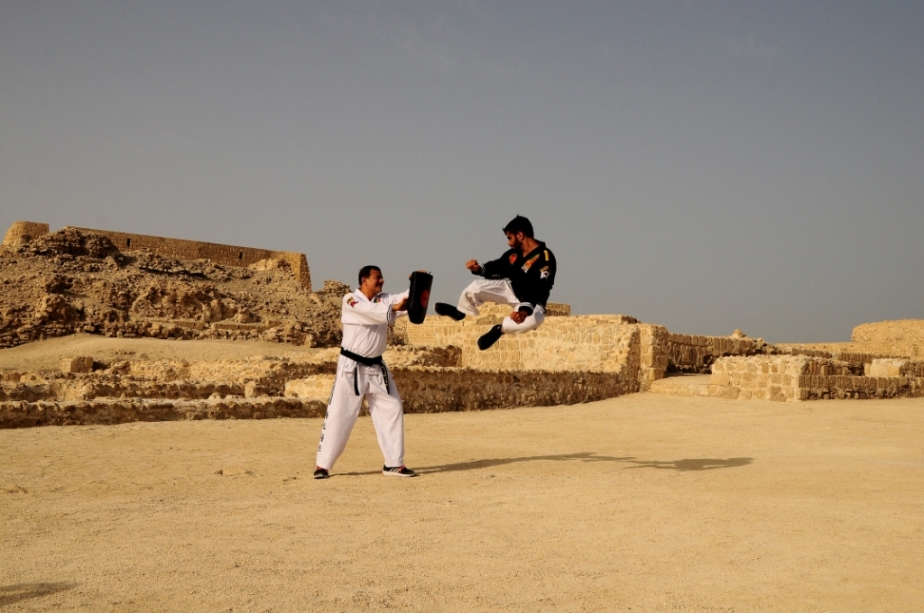Martial Arts, in any form, always was an exciting practice. A single photograph pinned to the wall seen while visiting one of the acquaintances at his office led to meeting the 6th dan black belt and winner of several gold medals, Master Salah Al Kharraz of Moo Moo Kwan Hapkido, Bahrain.
Master Salah Al Kharraz arrived with a gentle smile to the dojo in Seef. The clear and sharp eyes matched perfectly with the gentle, smiling face.

Inside the dojo at Seef, boys of ages ranging from 5-10 years were seen running around and playing. Still a few more minutes to go before their classes. The instructor, Master Ayyad, with a 2nd dan black belt, gently reminded the boys to greet the visitor. Each one of them then came running and greeted the visitor, that is yours truly. The discipline instilled through the practice of Hapkido is evident. In real life it is hard to expect any such kids to pay respect to an elder or even a peer. Having practiced martial arts myself, the magical effect brought in through years of practice on the overall control of self on any individual is quite amazing.
My Refractions.com met Master Salah Al Kharraz during early May 2015 at the dojo in Seef District, Bahrain.
Some excerpts from the interview that followed the meeting…
Thank you, Master, for the opportunity to meet with you and to spend some time.
You are most welcome and it is indeed a pleasure to be with you.
What is the meaning of Moo Moo Kwan?
Well, Moo Moo Kwan is a kind of school of Hapkido. The first Moo stands for the study and learning and the second Moo stands for the training and gaining strength. These two are like day and night; bad and good; dark and bright. Kwan is the school.
How did it all start? Why did you choose Hapkido?
It started in 1982. Initially I practised Karate and Aikido under Master Mohammed Fakhro. From 1986, I started focussing my training only on Hapkido. In Hapkido style, the energy of the opponent is avoided or deflected and may be redirected towards the source. Aikido, similar in several ways to Hapkido, does not have the Kicking and Striking techniques seen in Hapkido. I used to read several magazines that I purchase from wayside vendor in Bab Al Bahrain (internet was not common in those days). Hapkido training started in Sitra Yacht Club and later I moved towards promoting Hapkido under the auspices of the Federation.
What are the weapons used in Hapkido style?
Common weapons are sword, staff, cane and hand fan (Bu-chae). Sometimes, belt or a scarf is also used.
What else is taught within Hapkido?
Once you achieve 3rd degree black belt, you are taught curing and healing techniques. Fundamental philosophy of Hapkido is not to break things but to fix things.
What would be the greatest learning for a martial arts student?
“Fighting not to Fight”. In other words, if you have even 1% chance to avoid a fight, one must not fight.
Thank you very much, Master, for your kind words and time.
“Thank you for you visit and wish you the very best”, concluded the Master, as he accompanied till the door to see me off.
We parted that day with a promise to meet soon in an outdoor location where My Refractions would get to meet some of the instructors and students of the institute.
My Refractions received a message from the Master confirming the date and time of the next meeting.
One of the Fridays, we met at the Bahrain Fort in the Seef district. The team arrived sharp at 6.00AM. We had a few horse-riders, joggers, a few seagulls, bright morning sunshine and the silence of the Fort for our company. After a warming up session, the team broke into groups for the practice as the shadows shortened.
Some frozen moments during the practice session on that Friday morning is here for you…
Some photographs, courtesy Moo Moo Kwan Hapkido…
The photo session came to an end by 7.30AM but the roar of the Black Tigers continued to reverberate the walls of Bahrain Fort that silently whispered the glorious past and looked forward to another hundred years of peace and prosperity.




























